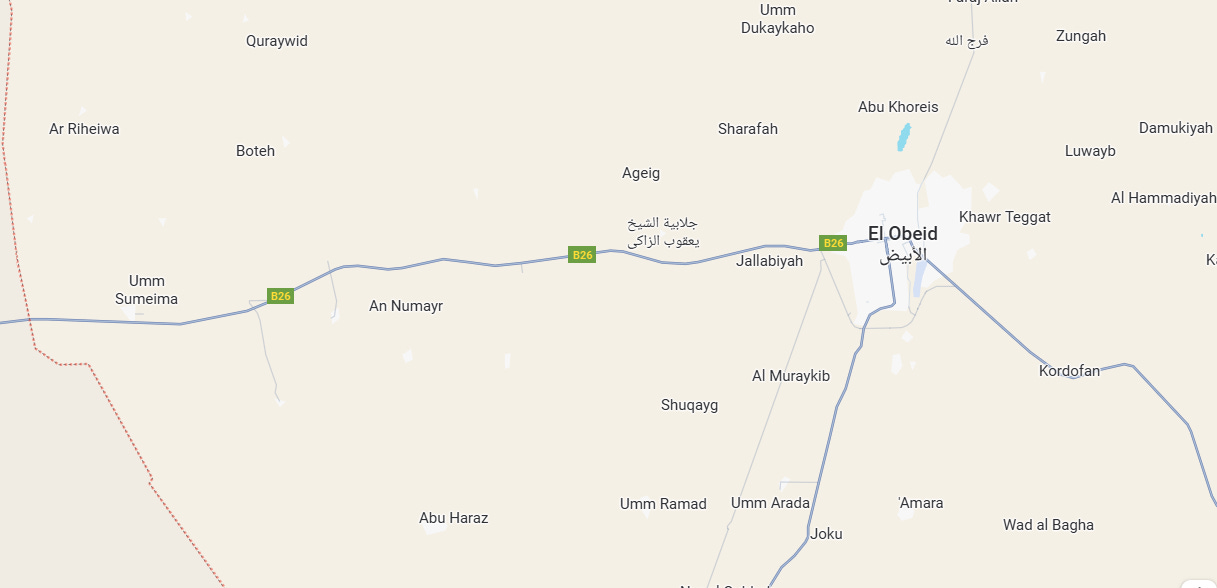Deadly confrontations outside El Obeid
Sudanese military fences off RSF attempt to advance on North Kordofan capital
Heavy clashes broke out last week in Sheikan Locality, North Kordofan state, after the paramilitary Rapid Support Forces (RSF) sought to advance on positions east of the state capital El Obeid.
The paramilitary group had been consolidating control of rural areas east of El-Obeid since late July, beginning with the capture of Um Sumaima on July 30. On August 3, RSF units seized Abu Qa’ud, a village about 40 kilometers east of the state capital, after heavy fighting with the Sudanese Armed Forces (SAF) and allied militias.
The fall of Abu Qa’ud gave RSF an important foothold close to El Obeid, a city they have long sought to capture since the beginning of the conflict in April 2023. Control of the village increased their ability to project pressure on the state capital, which is not only a military command center but also an administrative hub linking Khartoum, White Nile, Kordofan region, and Darfur.
On August 20, SAF, reinforced by the Joint Forces of former Darfur rebel groups and Islamist fighters from Baraa Bin Malik militant group, launched a counteroffensive from El Obeid. Their objective was to retake Abu Qa’ud and push RSF elements back toward the border of West Kordofan.
The movement followed the arrival of reinforcements from Khartoum and White Nile states a week earlier, brought in to bolster SAF’s position in North Kordofan after months of relentless RSF attacks and advances.
The paramilitary group anticipated the offensive and staged an ambush outside Abu Qa’ud, scattering SAF columns and inflicting heavy losses, including the death of Mohanad Ibrahim, a member of Baraa Bin Malik who had announced his deployment to the front days earlier. The ambush highlighted RSF’s ability to use open terrain and local knowledge to disrupt SAF advances.
However, the Sudanese military SAF regrouped outside El Obeid and attacked Abu Qa’ud the following day capturing it from the RSF. The paramilitary group was forced to pull back toward Um Sumaima.
Fighting raged across the plains as SAF deployed armored units in an attempt to advance to Um Sumaima, but RSF resistance remained strong, and by evening the army had withdrawn once more to Abu Qa’ud.
In the early hours of August 21, SAF and elements of the Joint Forces claimed to have recaptured Um Sumaima, but by about 1:00 p.m. RSF fighters appeared in a video outside the town’s health center, confirming the army’s retreat.
On Monday, RSF fighters were filmed digging trenches and cutting the El Obeid highway outside Um Sumaima.
This indicated preparations to defend the town against further SAF attacks, while preserving the ability to launch renewed offensives toward Abu Qa’ud and El Obeid. The trenching suggests a shift from purely mobile operations to fortified defenses designed to slow SAF advances.
North Kordofan’s significance to the warring parties
North Kordofan has emerged as one of the decisive fronts in Sudan’s conflict. Following the RSF’s expulsion from central Sudan’s Khartoum and Al Jazirah states earlier this year, the frontline shifted southwest into the Kordofan region, with the RSF struggling to hold to its positions around El Obeid.
For SAF, securing El Obeid and its environs is a prerequisite for advancing into West and South Kordofan, where its garrisons in Babanusa and Dilling (and state capital Kadugli itself) remain under siege. For the RSF, keeping pressure on El Obeid is central to preventing the army from regaining more ground in Kordofan.
However, the Sudanese military’s presence across the Greater Kordofan remain precarious. The military’s 22nd Infantry Division is encircled by the RSF in Babanusa, the last major town it holds in West Kordofan, while the 57th Brigade in Dilling is under a joint RSF-SPLA-North siege.
Clearing RSF units from these areas, as well as villages and towns north and south of El Obeid, is essential before SAF can claim full control in North Kordofan and turn deep toward West and South Kordofan as well as the Darfur region.
The ongoing battles also underline the mix of forces now active in the Kordofan axis. SAF operates alongside former Darfur rebel groups who signed the Juba Peace Agreement, while Islamist militias such as Baraa Bin Malik and Sudan Shield Force fight under its banner, boosting manpower but adding an ideological dimension to the conflict.
RSF, meanwhile, has relied on rural support networks and its alliance with the SPLA-North under Abdelaziz Al-Hilu, especially in South Kordofan, to maintain mobility and supply lines despite setbacks in direct engagements with the Sudanese military.
SAF has shown it can seize ground temporarily, but RSF continues to blunt its advances with ambushes and entrenched defenses. Both sides are heavily invested in the fight for El Obeid, which has become a symbol of control over Sudan’s central corridor.
Videos
Warning: Graphic Contents
In this video filmed on August 20, 2025, members of the Joint Force of former Darfur rebels film after scattering an RSF attempt to regain control of Abu Qa’ud in Sheikan locality, North Kordofan State.
In this video, RSF fighters are seen boasting over the body of Baraa Bin Malik member Mohanad Fadl Ibrahim, killed in an ambush on August 20, 2025, near Abu Qa’ud in North Kordofan.
In this video filmed on August 22, RSF soldiers film before the Um Sumaima health office dismissing claims by elements of the Sudanese military that they have taken control of Um Sumaima.
In this video, Joint Forces fighters recover the vehicle of Baraa Bin Malik member Mohanad Fadl Ibrahim who was killed during fighting outside Abu Qa'ud by the RSF on August 20.




Do you think an SAF victory over El Obeid will be undercut by an RSF takeover of El Fasher? Although securing El Fasher would eject the SAF from its last remaining stronghold from Darfur, providing the RSF near full control over West Sudan, El Obeid's place in the oil rich Kordofan region can't be understated.